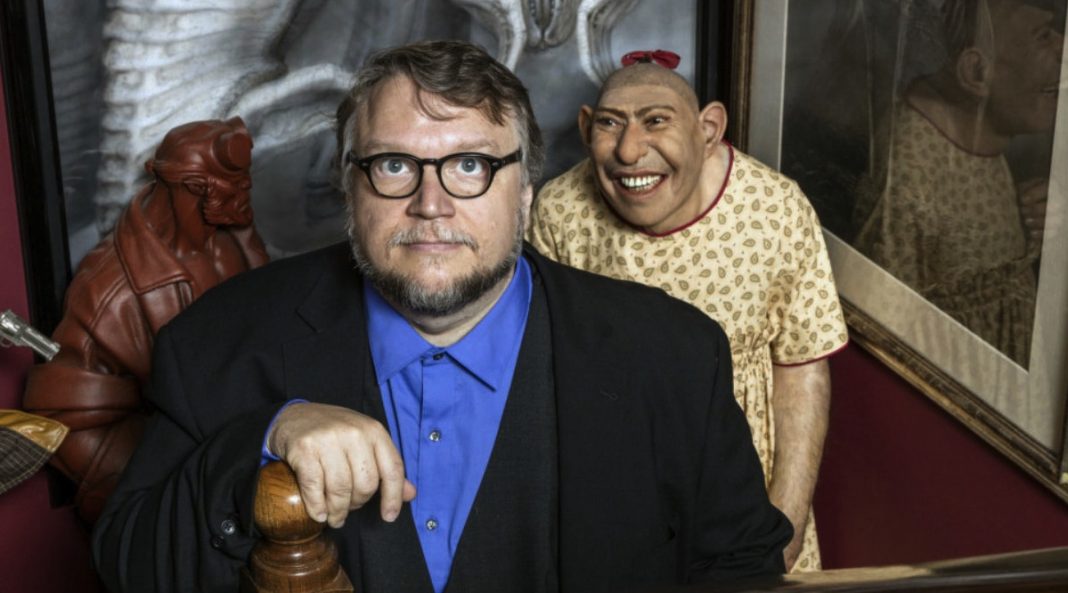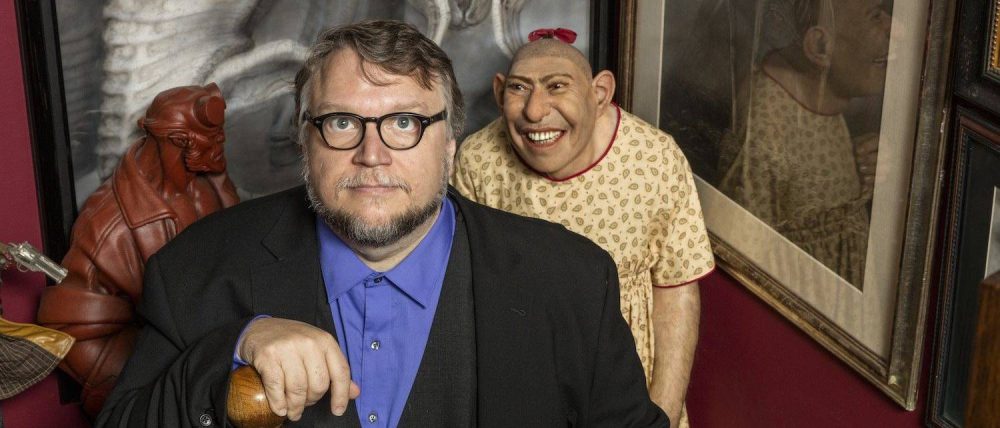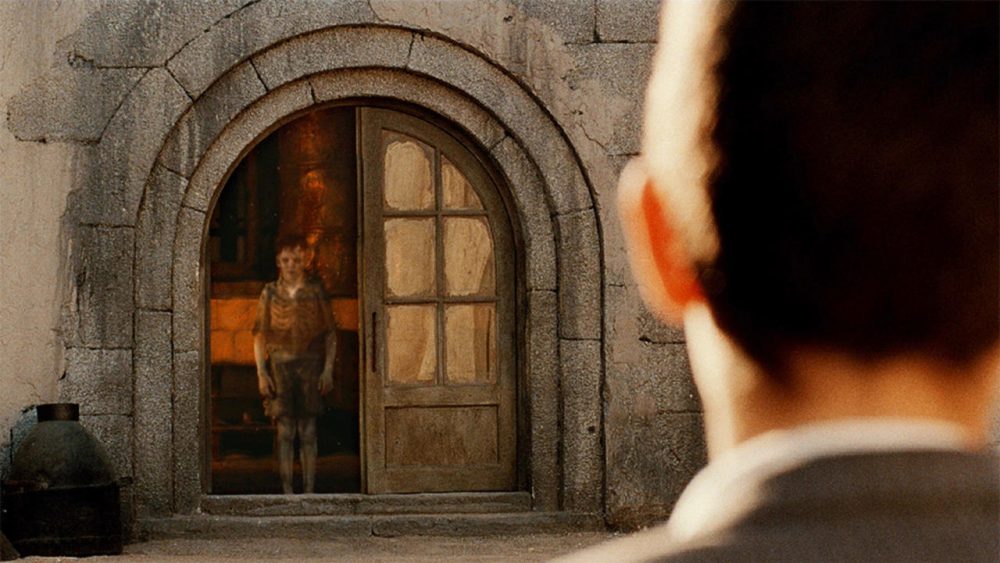Spoilers ahead for several Guillermo Del Toro films.
I was first enchanted by Mexican writer/director Guillermo Del Toro when I was 12, sneaking in parts of Blade II on HBO or some other premium cable channel, hoping my parents wouldn’t catch me watching an R-rated movie. I never saw it in its entirety until this past weekend, but a few images at a time of the cooler-than-cool title character (Wesley Snipes) slicing and dicing vampires was enough to permanently alter my psyche. It’s evident in my own work.
In the years since, Del Toro became my favorite filmmaker. I’ve seen all ten of the films he’s directed, from his 1993 debut, Cronos, to his most recent release, 2017’s The Shape of Water, for which he earned Academy Awards for Best Picture and Best Director. As a lifelong fan of genre storytelling, I’m drawn to his memorable creature designs, gut-punch character moments, and the sense of humor and heart he brings to even his darkest efforts. Yet there’s a theme in almost all of Del Toro’s work that draws me to him more than anything: as strange and terrifying as the literal monsters that populate his films may be, nothing is more monstrous than mankind itself.
This is not necessarily a novel concept, especially for a filmmaker as indebted to the horror genre as Guillermo Del Toro. The theme of a horror story is rarely as literal as “zombies are scary and want to kill you.” Horror stories have always been used to expose and warn us against any number of real human problems, such as universal hardships like childhood alienation or historically significant issues like white flight. What sets Del Toro apart is his juxtaposing literal monsters with monstrous humans.
All of Del Toro’s films prominently feature characters who at first glance would seem to be nightmare creatures, like the titular protagonist of Del Toro’s two Hellboy films. As superhero films (based on the comics by Mike Mignola), the fact that Hellboy (Del Toro mainstay Ron Perlman) is the “good guy” isn’t presented as a twist. Yet it’s still thematically significant that we’re meant to root for a scarlet-skinned, horned humanoid whom we’re immediately told is the son of the Devil.
So who are the bad guys in 2004’s Hellboy and 2008’s Hellboy II: The Golden Army? Well sure, Del Toro gives him plenty of other monsters to fight, like frog demons and a giant tree god. But there’s a difference between the cannon fodder adventure films throw at a hero and actual antagonists. As with all Del Toro films, humanity is the real villain, from the nazis who tried to weaponize him for their own nefarious purposes, to the paranoia and superstition plaguing humankind as a whole that prevents Hellboy from living a happy life outside of the American government’s control.
This “man is the real monster” theme is particularly effective when Del Toro explores the all-too-real horrors of fascism, as he did with 2001’s The Devil’s Backbone. Set in an orphanage during the final days of the Spanish Civil War, its depiction of leftists futilely trying to defeat the fascists who would soon gain control of Spain makes this Del Toro’s saddest film. The supernatural horror element comes in the form of a ghost (Junio Valverde) who haunts the orphanage, but the specter isn’t presented as adversarial for long. He was a child, and a victim of a flesh-and-blood man’s (Eduardo Noriega) all-too-human hubris and cruelty. The explosive climax ends with the death of the kindly Dr. Casares (Federico Luppi), who promptly turns into a ghost to protect the orphans from the traitor who threatened the children’s lives, as well as the adults’ desperate political cause.
The Devil’s Backbone is not viscerally scary in the traditional sense, and while most of Del Toro’s films can be classified as horror films, I would argue that none of them are scary in the way most horror films attempt to be scary. What makes The Devil’s Backbone terrifying is its proximity to what we’re going through in the present-day real world. Ghosts don’t scare me. Not really, when I’m so much more horrified by the fascists right here in my home country of the United States, right now in 2020. I’m pretty sure a little ghost boy won’t make me solve his murder. But I don’t know if the fascists who have already taken power in our government will be defeated. It didn’t work for the cast of The Devil’s Backbone, just like it didn’t work for real people in 1930s Spain.
The spiritual sequel to The Devil’s Backbone, 2006’s Pan’s Labyrinth, may be even darker, but for Del Toro’s scariest (and arguably best) film, it ends on a strangely more hopeful note. Set in 1944, the fascists have now thoroughly overtaken Spain. Our lead character, 10-year-old Ofelia (Ivana Baquero), is taken into the belly of the beast when her hapless mother (Ariadna Gil) marries the brutal Captain Vidal (Sergi López) and becomes pregnant with the Francoist tyrant’s baby.
Ofelia comes to believe that a better path lies ahead for her when a creepy fawn (Doug Jones, who learned Spanish for the role) convinces her that she’s a princess of the underworld, and gives her a series of tasks to fulfill her destiny. Del Toro has described Pan’s Labyrinth as a parable, so given the themes it explores, it’s no surprise that the fantastical creatures Ofelia meets on her dark misadventures aren’t exactly friendly. Yet they’re still not as scary as the atrocities committed by the Francoist forces. Fernando Tielve and Íñigo Garcés, who played the lead orphan boys in The Devil’s Backbone, even make cameo appearances as leftist freedom fighters killed by Captain Vidal and his men.
Luckily, the film ends with the death of Captain Vidal and the suggestion that the tide of fascism would soon be turned back (which did eventually happen in real-world Spain) but not without the death of young Ofelia. Even so, if you interpret the epilogue literally, she joined her parents at their thrones in the underworld and was venerated as Princess Moanna. Not exactly what one might think of as a happy ending, perhaps, but ascending to demonic royalty is a better fate than fascist triumph.
2017’s The Shape of Water may be Del Toro’s most optimistic film, as well as his most blunt expression of the “man is the real monster” theme. Set in 1962 Baltimore during the height of the Cold War, the only supernatural creature here is the amphibious fish-man (Doug Jones) whom a mute woman named Elisa (Sally Hawkins) falls in love with after discovering him captive at the secret government facility where she works as a cleaner.
He’s a bizarre, initially frightening creature, so building a romance film around him can present a barrier to some viewers.Yes, this is the movie where “a lady fucks a fish man” if you want to be reductive about it. That’s a shame, because by inverting the “Beauty and the Beast” tradition several times over, Del Toro created a beautiful story about radical empathy, and desperately holding onto what little you have. It’s so much more nuanced and emotional than what it seems like on paper.
The “misunderstood monster” is hardly a unique premise in sci-fi and fantasy storytelling, dating back to King Kong and Frankenstein and beyond. One thing that makes Del Toro’s take on the trope special is his pitting the fish man in the middle of the political conflict between the Cold War-era Soviet and American governments. Americans are used to depictions of the USSR as mustache-twirling villains, but in The Shape of Water, American forces aren’t portrayed to be much better. American Colonel Richard Strickland (Michael Shannon), leading the project studying the fish man, represents a uniquely American variety of genteel authoritarianism. He’s violently dedicated toward creating the impossibly perfect white-picket-fence suburban life for himself and his family, and when he’s too vain to treat a gruesome hand injury, it festers into a horrifying monstrosity.
It’s not just the American government that’s portrayed as violently small-minded, but American culture. Elisa’s elderly friend and neighbor, Giles (Richard Jenkins) is a gay artist who’s never been free to come out of the closet due to pervasive homophobia. When he finally makes a romantic gesture toward a handsome male acquaintance, the man threatens him.
Even in Del Toro’s lesser efforts, the “man is the real monster” theme comes through in subtle ways. Take 1997’s Mimic, his first English-language film and easily his weakest, due largely to the director being treated so poorly by Miramax that his friend James Cameron tried to physically fight Harvey Weinstein. It’s the only Del Toro film I wouldn’t wholeheartedly recommend, but its story of a deadly virus exacerbated by human folly is eerily prescient in the time of COVID-19. Its biggest twist is the reveal that the hulking bug monster that’s been terrorizing the New York City streets has gone largely undetected because it developed the ability to “mimic” the appearance of its greatest threat: humans. It’s a disgusting, dark mirror of humanity itself.
Similarly, while 2002’s Blade II is a fun monster action movie that surpasses its predecessor, it’s a sequel to a 1998 film Del Toro had nothing to do with, and therefore feels like his least personal film. Even so, his fingerprints are all over this sequel, from the delightfully hideous design of the “super vampires” to Blade’s doomed romance with a vampire princess. And while the primary villains are literal vampires (Blade’s whole deal is that he’s a half-vampire who hunts full-vampires) Del Toro still sneaks in his “man is the real monster” theme. The aristocratic vampire clan that dupes Blade into helping them is facilitated by a slimy human lawyer (Karel Roden), and Blade is betrayed by his human assistant, Scud (Norman Reedus). Meanwhile, the egotism and deception that tears the cast of vampires apart isn’t much different from what humans are capable of.
Del Toro’s “man is the real monster” theme never manifests in quite the same way. Yet he consistently tells us that the greatest threats to humanity don’t look like the ghosts of Crimson Peak or the kaiju of Pacific Rim. We are our own greatest enemies.










